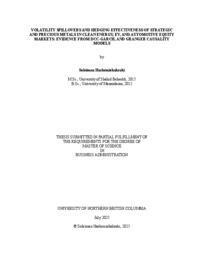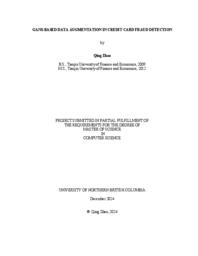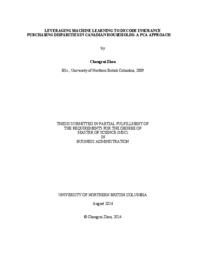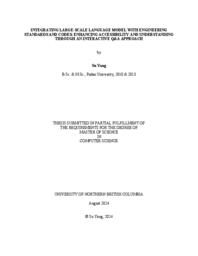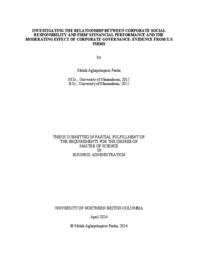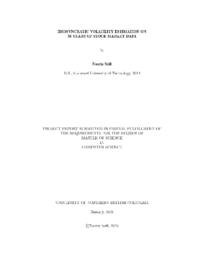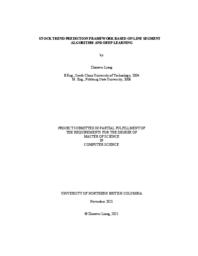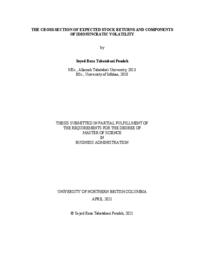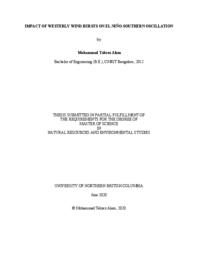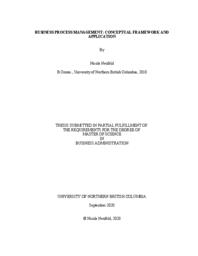Fu, Chengbo
Person Preferred Name
Chengbo Fu
Related Works
Content type
Digital Document
Origin Information
Content type
Digital Document
Origin Information
Content type
Digital Document
Origin Information
Content type
Digital Document
Origin Information
Content type
Digital Document
Origin Information
Content type
Digital Document
Description / Synopsis
This comprehensive study delves into the intricate connections between economic and financial factors and carbon dioxide (CO2) emissions across G20 nations (excluding the European Union) spanning 1994 to 2021. our investigation, utilizing a multiple linear regression model, meticulously examines diverse energy consumption types, financial institutions, life insurance premiums, economic factors, and the aftermath of the 2008 financial crisis. Our preliminary findings reveal robust links between various energy sources, financial institutions, life insurance volumes, and CO2 emissions. Notably, the Financial Institutions Index and Life Insurance Premium Volume unveil novel insights that can add new visions to conventional perspectives. Recognizing the influential role of the G20 on a global scale, our research aspires to inform and guide sustainable policy decisions. Methodologically, after a comparative evaluation of various data transformation methods, we employ a cube root transformation to enhance analytical precision. Also, Principal Component Analysis (PCA) reveals underlying patterns in the data. Granger causality tests shed light on temporal relationships, complementing the robust quantification of each variable's impact on CO2 emissions derived from the linear regression model. Rigorous validation, including Durbin-Watson, Breusch-Pagan, Shapiro-Wilk, RESET, Bonferroni Outlier test, and ADF stationarity tests, ensures the reliability of our results. Our linear model enhances interpretability and provides clear insights into the determinants of CO2 emissions. This research significantly contributes to the field by extending our knowledge of the complex factors influencing CO2 emissions. It unveils unexpected relationships, underscores the pivotal role of financial institutions, explores the repercussions of economic crises, and provides practical policy implications. Methodologically, our study stands out for its advanced statistical analyses. This research yields a valuable understanding of the sustainability framework, presenting a nuanced view for policymakers, researchers, and practitioners alike. This study enhances the academic speech by thoroughly addressing the factors influencing CO2 emissions and delivering a foundation for informed decisionmaking in pursuing a more sustainable future.
Origin Information
Content type
Digital Document
Description / Synopsis
Many studies have examined the relationship between corporate social responsibility (CSR) and a firm’s financial performance. These investigations have had mixed results. Some studies find a positive relationship, others find a negative relationship, and yet some studies find no significant relationship. This ambiguity highlights the complexity of the relationship between CSR initiatives and firm performance. The present study attempts to better understand this relationship. As such, it has two objectives. Since most of the previous studies have examined a linear relationship between CSR and a company's financial performance, the first objective of this study is to investigate whether there is any nonlinear relationship between CSR and firm’s financial performance. The second objective of this study is to examine the moderating effects of corporate governance factors, especially the board of directors’ characteristics such as board size, board independence, board gender diversity, and CEO duality on the relationship between CSR and a firm’s financial performance. The latter factors have not been fully considered in previous studies as the focus has been on the direct link between CSR and the firm’s financial performance. The study uses panel data from a sample of 82 firms from a large group of publicly traded American firms, which are listed on the U.S. stock exchange and are part of the S&P 500 index covering the years 2012-2021, and a nonlinear panel regression model to estimate the relationship between firm’s financial performance as measured by Return on Asset (ROA) and CSR disclosure index along with a control variable and four Corporate Governance indicators and their interactions with CSR disclosure index. The study finds a non-linear positive relationship between firm’s performance and CSR, suggesting a declining effect of CSR on firm’s performance at higher levels of CSR. It also finds that board gender diversity positively affects the relationship between CSR and a firm’s financial performance. We find no statistically significant interactions between CSR and the Governance indicators of board size, board independence and CEO duality.
Origin Information
Content type
Digital Document
Description / Synopsis
Financial markets require a great deal of decision making from the investors and market makers. One metric that can help ease the process of decision making is investment risk which can be measured in two parts; systematic risk and idiosyncratic risk. Clear understanding of the volatilities in each risk component can be a powerful signal in recognizing the right assets to maximize the investment returns. In this project, we focus on the idiosyncratic volatility values and provide an easy to use source code implementation that can pave the road for future studies on the relation between the idiosyncratic volatility and the chosen asset return values. Using our implemented source code, we pre-calculated the idiosyncratic volatility values for 31,198 members of NYSE, Amex and Nasdaq markets for the trade dates occurring between January 1963 and December 2019, and release this dataset along with our implemented source code. Additionally, we consider the application of machine learning techniques in predicting the idiosyncratic volatility values using the raw trade data to explore a data extension option for the future market trade records that have not yet occurred. We offer a deep learning based regression model and compare it with traditional tree-based methods on a small subset of our per-calculated idiosyncratic volatility dataset. Our analytical results show that the performance of the deep learning techniques is much more robust in comparison to that of the traditional tree-based baselines. However, more work needs to be done to be able to use a machine learning based model to reliably predict the idiosyncratic volatility values using the raw trade records.
Origin Information
Content type
Digital Document
Description / Synopsis
Stock forecasting is a very complicated task due to its noise and volatile characteristics. How to effectively eliminate the noise has attracted attention from both investors and researchers. This report presents a novel de-noise technique named Line Segment Algorithm (LSA). Compared to those signal processing methods, LSA is based on the characteristic of financial time series. First, the algorithm identified the shape patterns of the historical stock price series and labeled them as turning points and false alarms. Then, a stock trend prediction framework was built and trained with the shape patterns extracted by the algorithm. Eventually, the model could predict whether a shape pattern is turning point or not. To evaluate its performance, experiments on the real stock data were carried out in LSTM and Random Forest, respectively. The results show that LSA demonstrates its effectiveness by better accuracy on prediction. It provides a new perspective for stock trend analysis and can be applied in the actual stock investment trading as well.
Origin Information
Content type
Digital Document
Description / Synopsis
We examine the relationship between stock returns and components of idiosyncratic volatility—two volatility and two covariance terms— derived from the decomposition of stock returns variance. The portfolio analysis result shows that volatility terms are negatively related to expected stock returns. On the contrary, covariance terms have positive relationships with expected stock returns at the portfolio level. These relationships are robust to controlling for risk factors such as size, book-to-market ratio, momentum, volume, and turnover. Furthermore, the results of Fama-MacBeth cross-sectional regression show that only alpha risk can explain variations in stock returns at the firm level. Another finding is that when volatility and covariance terms are excluded from idiosyncratic volatility, the relation between idiosyncratic volatility and stock returns becomes weak at the portfolio level and disappears at the firm level.
Origin Information
Content type
Digital Document
Description / Synopsis
Westerly wind bursts (WWBs), usually occurring in the tropical Pacific region, play a vital role in El Niño–Southern Oscillation (ENSO). In this study, we use a hybrid coupled model (HCM) for the tropical Pacific Ocean-atmosphere system to investigate WWBs impact on ENSO. To achieve this goal, two experiments are performed: (a) first, the standard version of the HCM is integrated for years without prescribed WWBs events; and (b) second, the WWBs are added into the HCM (HCM-WWBs). Results show that HCM-WWBs can generate not only more realistic climatology of sea surface temperature (SST) in both spatial structure and temporal amplitudes, but also better ENSO features, than the HCM. In particular, the HCM-WWBs can capture the central Pacific (CP) ENSO events, which is absent in original HCM. Furthermore, the possible physical mechanisms responsible for these improvements by WWBs are discussed.
Origin Information
Content type
Digital Document
Description / Synopsis
Recent literature published by some practitioners, consultants, and researchers in the area of Business Process Management (BPM) identified that BPM is a new and emerging field of research and practice. The objective of this paper is to identify the conceptual framework of BPM, identify if connections exist with prior process improvement concepts such as Business Process Re-engineering (BPR), Total Quality Management (TQM) and Business Process Improvement (BPI), and apply BPM in a case study to determine the effectiveness of the current methodology. An extensive literature review was conducted, identifying multiple similarities between BPM and prior process improvement concepts, suggesting an evolving nature of the concept. The BPM methodology was then applied in a controlled case study, identifying a major inefficiency in the methodology. The findings of this paper are useful to researchers, educators, students, and managers to understand the evolution of BPM, and determine how it can be applied.
Origin Information

